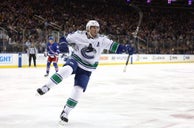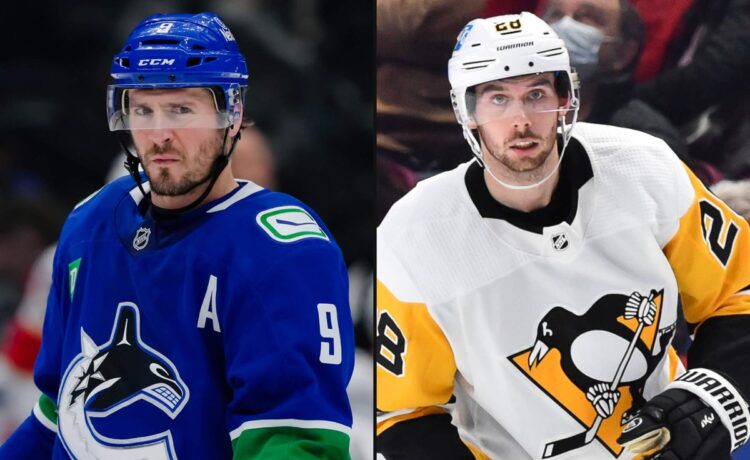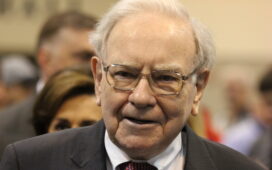Across a pair of complicated blockbuster trades on Friday night the Vancouver Canucks remade their roster and charted a new path forward for the franchise.
In the first move, the Canucks shed one of the most productive players in franchise history due to locker room issues. They acquired a younger pivot and an intriguing blue-line prospect. They rented a high-value first-round pick for a couple of hours. In the second move, the Canucks cleared salary-cap space and rid themselves of a couple of free-agency errors from last summer. They dealt a forward prospect. And they brought in a top-four defender and a middle-six winger with size, expiring players the club nonetheless intends to be long-term fixtures in Vancouver.
In the wake of the Canucks’ transactions late Friday evening, fans are left with a number of big questions. How did the Canucks get here? How did the deals come together? And what comes next?
Here are 10 thoughts on what occurred, the launch of the post-J.T. Miller era and how to make sense of Vancouver’s approach moving forward.
1. The end of an era
Since Jim Rutherford and Patrik Allvin were hired midway through the 2021-22 season, the club has been laser-focused on supporting the core group it inherited from Jim Benning.
Canucks management eschewed a rebuild and instead sought to make moves that would bolster the roster short-term. Brock Boeser was retained, Miller and Elias Pettersson were extended and the club sought out upgrades for Pettersson’s line (Jake DeBrusk) and Quinn Hughes’ pair (Filip Hronek). The Canucks have behaved and believed that this core was good enough to win together.
I still don’t know exactly why that changed this season, but something shifted dramatically internally. Right from training camp, whatever long-dormant issues Miller and Pettersson have had with one another popped up. In November, Miller took an unexplained 10-game personal leave.
The dysfunction seeped into the wider room. Canucks management came to believe that whatever was going on behind the scenes was impacting the entire team.
Still, the club didn’t want to deal Miller. There’s an understanding internally that his on-ice contributions are irreplaceable.
Perhaps as time passes we’ll find out more details about precisely what happened here, but given the fact pattern and what’s occurred, it’s impossible not to conclude that it must’ve been a whole lot worse behind the scenes than the public has even imagined.
2. Elias Pettersson is off the block
Don’t misinterpret the club’s actions on Friday as “blaming Miller” for the chemistry issues that caused the club to determine that they couldn’t move forward with both Miller and Pettersson.
Miller and Pettersson are equally at fault for what’s transpired here. I can’t remember ever encountering a situation quite like it across 15 years of covering and working in the sport.
That said, the decision has been made. Miller is a New York Rangers player again, and the Canucks will move on with Pettersson. Obviously, it’s that time of year when things can change with one phone call, but Pettersson shouldn’t be expected to move before the NHL trade deadline at this point.
It goes without saying that the team expects more from its $11.6 million man than he’s delivered this season, specifically in terms of his preparation and his leadership. He’s going to have to step up, and he knows that.
Pettersson’s no-move protection kicks in on July 1, 2025, and it will be fascinating to see if the club revisits all of this at the draft should Pettersson continue to struggle. In the short term, however, the Canucks’ hope is that Pettersson will find his game and perform like the top-level centre that the club requires him to be.
3. How the deals came together
The Canucks and the Rangers have held on-again, off-again trade talks involving Miller dating back a couple of years, but things really crystallized across the past several weeks.

GO DEEPER
Inside the J.T. Miller trade: After 3 years, how the Rangers finally got their guy
The two sides got close to consummating a deal two weeks ago, but the Rangers pulled out of that trade. The Canucks, it seems, weren’t especially pleased by whatever stopped that original deal, but other suitors always felt like the Rangers were still in the driver’s seat in pursuing Miller. Based on the price they were willing to pay Friday, that tracks.
It seems that the Pittsburgh Penguins — and talks about the secondary trade to complete Vancouver’s Friday night two-step — were involved relatively early on in the process.
4. Marcus Pettersson and Drew O’Connor’s expiring status
As exceptional as Miller is, given his age and the term remaining on his deal, the most valuable asset in both trades was the Rangers’ protected 2025 first-round pick, which could convert to the 2026 draft if it falls within the first 13 picks in 2025.
Parting with that pick in order to acquire Drew O’Connor and Marcus Pettersson, who are both on expiring contracts and bound to be unrestricted free agents on July 1, is a risky maneuver from a Canucks perspective.
The club, however, isn’t viewing either player as a rental. Although Vancouver didn’t get permission to discuss extensions with either of them prior to executing the trade on Friday night, the Canucks are confident about their ability to get both extended and intend to open extension talks this weekend or early next week with O’Connor and Pettersson’s respective representatives.
Obviously, there’s an established comfort level with both players. Rutherford traded for Pettersson and signed O’Connor, who was identified and recruited to Pittsburgh by Canucks director of player personnel Scott Young, to his entry-level contract during his tenure as Penguins general manager.
These can be tricky negotiations. By trading for expiring players, the Canucks will be opening contract talks on the back foot from a leverage perspective. Vancouver, however, wanted to strengthen the team despite dealing Miller and wanted to get out ahead of the trade market — especially on Pettersson — given its anticipation of an especially competitive free-agent market on July 1.
Of course, if extension talks go sideways, the club still has time before the deadline to move either player and recoup assets. The intention, however, is to get extensions done with O’Connor and Pettersson, and that’s probably required to really justify the high acquisition price.
5. Fit over value
In the past when I’ve been most critical of the Rutherford and Allvin regime, it’s been as a result of deals like their second trade on Friday night. I fundamentally believe that NHL teams seeking a championship-level ceiling should be more preoccupied with value, whereas this hockey operations group consistently prioritizes hockey fit above all else.
In this instance, the Canucks felt that the need to upgrade both their overall depth and blue-line quality was urgent. The club hasn’t been pleased with how a pair of unrestricted free-agent signings in Vincent Desharnais and Danton Heinen panned out. The Canucks wanted to upgrade the pace and size of their forward depth and needed a defender with more puck-moving ability outside of the top pair.
O’Connor’s forechecking ability, in particular, is something the club valued highly. And while his goal scoring totals have been more pedestrian this season after last year’s breakout, the Canucks see him as a credible secondary scoring threat and a bona fide top-nine option. Pettersson’s defensive steadiness and puck-moving ability have been sorely needed by Vancouver all season and he’s viewed as a legitimate top-four option on the back end.
6. Filip Chytil
Vancouver has been relatively high on Filip Chytil for a while, although that’s somewhat qualified. The skilled 25-year-old pivot is viewed as a talented player, but not a player that’s really managed to put it all together consistently to this point in his NHL career. The Canucks tasking him with being an everyday second-line centre may be something of a stretch, and he may be best suited to a third-line role over time.
Chytil is going to get every opportunity to run with the chance to play second-line minutes down the stretch here, though, and the club is going to rely on him to soak up some difficult minutes and remain productive. A rate-scoring ace with a solid play-driving record, it’ll be fascinating to see if he’s able to handle what’s about to be thrown at him.
As for the suspected concussion issues that Chytil has dealt with over the past few years and the risk factor that creates, the club did its homework on his history of head injuries. It seems the Canucks are comfortable that Chytil’s durability risk isn’t quite as significant as it’s been characterized in public.
7. Operation: replace J.T. Miller
Miller is one of the most unique and productive players in Canucks history. Replacing him is a virtually impossible task and the organization understands that.
From this point forward, finding another credible top-line or top-six calibre centre is now the top priority for the Canucks. The club will be on the hunt for a centre upgrade leading up to the NHL trade deadline. That search will then continue at the draft. And it will end up as the primary offseason priority too, if it hasn’t been addressed already by then.
This is now Vancouver’s greatest area of need.
8. The Victor Mancini thing
The Canucks seem to be pretty excited about Victor Mancini, the 6-foot-3, right-handed defender that they acquired as one of the future pieces in the Miller trade. Canucks scouts are enamoured with his combination of speed and size, and he’s viewed both as a good fit for how the club wants to play, and a piece with significant exchange value too.
Mancini was in the AHL at the time of his acquisition but I’d expect him to get an NHL look at some point this season.
9. What comes next?
The Canucks both sold and bought on Friday evening, which is a testament to their unique situation. One point out of a playoff spot, Vancouver is still heavy favourites to ultimately get in, but there’s a lot of work to do for the Canucks to punch their ticket over the balance of this campaign.
Making the playoffs is always an organizational priority in Vancouver, but the club’s performance between now and March 7 will dictate a fair bit of what it decides to do.
On the expiring contract front, for example, it seems like the club is open to keeping pending unrestricted free agents like Pius Suter and Derek Forbort beyond the deadline as own rentals, but that will ultimately be contingent on how the club performs. If the club is comfortable with its odds of making the playoffs and where the team game is tracking, the Canucks will likely pass through the deadline with some of their pending unrestricted free agents on the roster, regardless of whether they have extensions in hand with those players or not. If the club falls out of it, however, that arithmetic will change.
It goes without saying that Boeser is the really big decision on the pending UFA file. My read of the situation is that the club views going to eight years on Boeser’s next contract as prohibitive, but management still likes the player and seems to be considering their options, even if contract talks have largely been quiet this season. Boeser is in a very different bucket in terms of what the club is considering in comparison with the Suter and Forbort types.
10. Why the Canucks aren’t going to be classic buyers
The Canucks were comfortable with quickly sending on the Rangers’ protected first-round pick to facilitate the acquisition of a depth winger and a top-four defender, but despite what that move implies and despite the surplus cap space (due to how they’ve managed their in-season cap in addition to the salary commitments shed in the Miller deal), they aren’t necessarily intent on being outright buyers in the weeks to come.
This is a club that’s middling it, somewhat. The Canucks are focused on short- and long-term goals simultaneously and attempting to balance them effectively. It’s not an easy trick, nor is it a path that generally gives a team the greatest odds of winning the Stanley Cup.
For example, I suspect it would take landing a long-term top-six centre fit to convince Vancouver to trade its own 2025 first-round pick ahead of the deadline.
(Photos of J.T. Miller and Marcus Pettersson: Derek Cain and Minas Panagiotakis / Getty Images)




